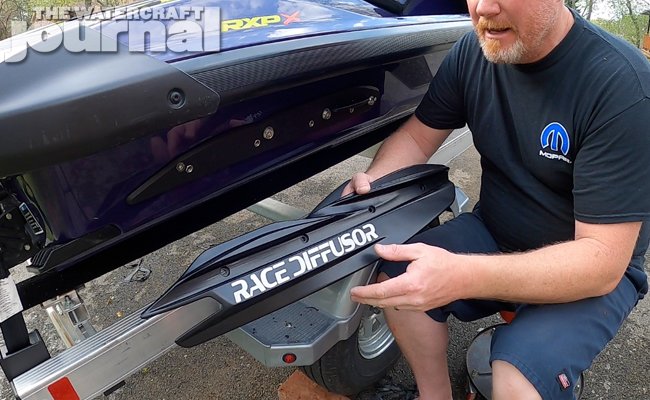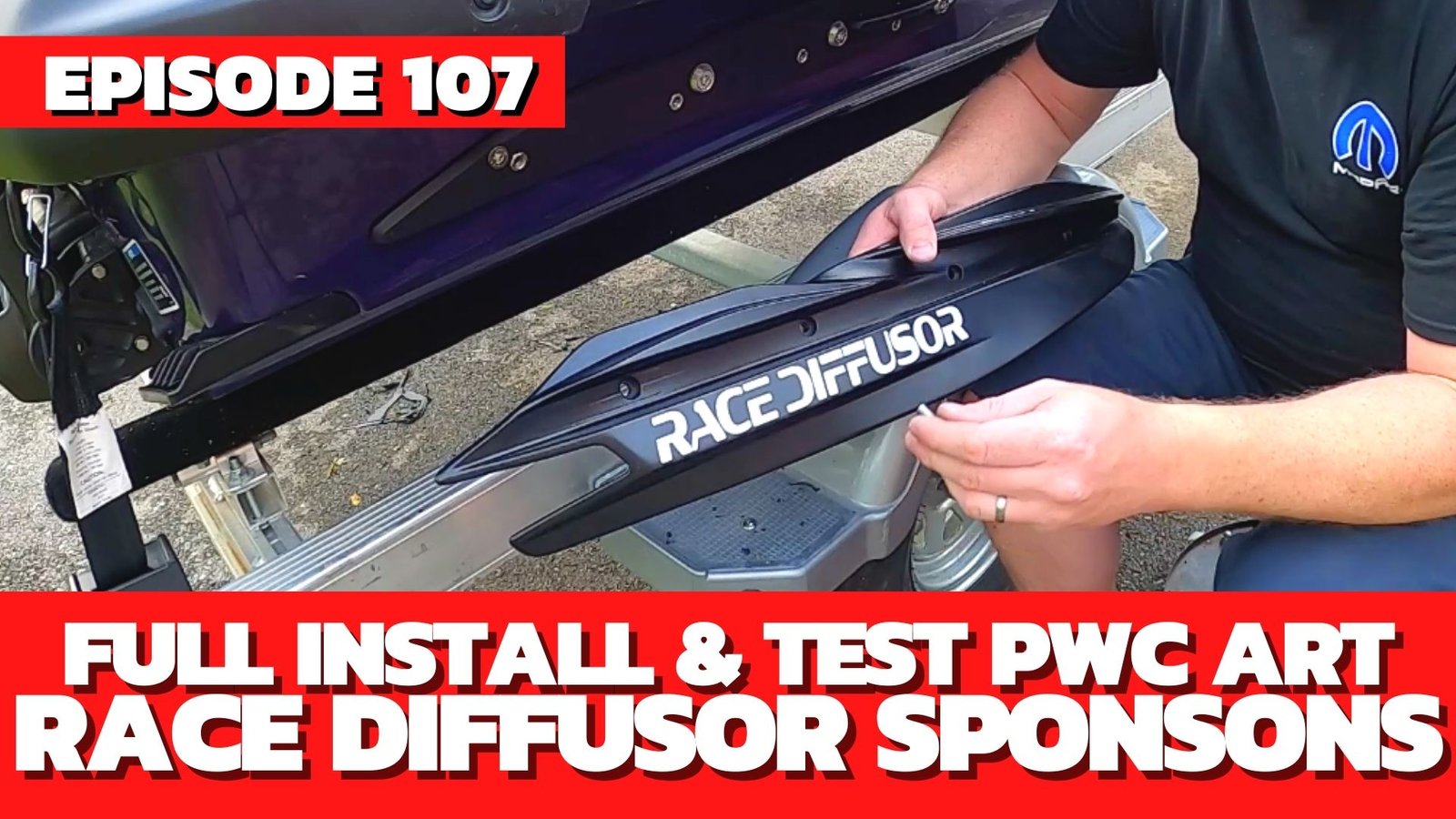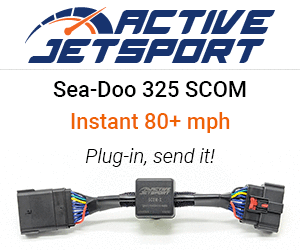
Since it’s 2021 redesign, the Sea-Doo RXP-X 300 has been taking up quite a bit of attention from the performance aftermarket. Whether it’s chasing top speed gains, ramping up acceleration curves or tightening up the ski’s cornering, there’s no shortage of parts and components that can push the RXP-X to new levels.
In previous testing, we found that RIVA Racing’s Pro Series sponsons provided solutions to behaviors of the hull, particularly in specific conditions. The negative camber angle of the machined ride plate extended the adjustable blades outward, with the deepest portion of the blade in front. This feature manually moves the watercraft’s pivot point forward, parallel with the intake grate.
This in turn, gave the RXP-X a far firmer axis in a corner, permitting the rider to throttle harder in the turn as the blades dug deep into the water, following the rolled outside chine in the hull. The overall length and length gives the sponson considerable contact, and as such, generates some drag to help make the turn a bit more manageable.
This way, the RIVA-equipped RXP-X enjoys a natural roll (or lean) into the approach, feels solid at the apex, and exits the turn – hard under throttle, of course – in a predictable transition. For most enthusiasts looking for better cornering capabilities and some dramatically improved straight-line tracking in chop, we recommended setting the Pro Series’ blades at the “neutral” #3 position.
After giving repeated (and greater detailed) reviews of RIVA Racing’s sponsons, The Watercraft Journal was approached to evaluate another set of sponsons for the 2021-and-up Sea-Doo RXP-X 300. The Race Diffusor sponsons from PWC-Art might not be on everyone’s radar because the company is still in its nascent stages. Even the website is still being developed.
Even as of this writing, the site does not include a listing for the Race Diffusors – so don’t expect to find a retail price, shipping information or otherwise just yet. Again, they’re working as fast as they can to build a digital shopping portal. So we felt very lucky to get our hands on these, as the only other American we knew of to try them was Sea-Doo racer Anthony Radetic during this year’s King’s Cup.
At the outset, the Race Diffusors feel hefty; the heavy cast blade comes in at nearly 6-pounds each (including the machined backing plate). For comparison, the RIVA Pro Series came in slightly less than a pound under the PWC-Art entry (5.1lbs. vs. 5.95lbs.). And the large casting Race Diffusors have a slim backing plate compared to the RIVA’s thin resin blade and composite backing block.
Of course, the biggest difference is the Race Diffusors’ unique design. Shorter than both the RIVAs and the factory plastic sponsons, the PWC-Art offerings feature an inverted-impeller blade design, rolling a deep-set C-channel that directs flow under and outward from the hull, with a through vein channeling water straight back, with two lift wedges diffusing water flow and providing some downward force.
At first blush, we were very excited to try these out. The thin backing plate is cut in a familiar airfoil teardrop-shape, exactly mimicking the wing of an airplane. The long, flat edge runs along the bottom allowing high pressure water to move quickly, as low pressure water runs up and over the sponson, generating lift. This is exacerbated by the plate’s 5-points of adjustability, raising or lowering the front spar. For our test, we kept the sponson set at neutral.
In our video (embedded below) we detail the steps taken to properly install the hardware. This was done following similar instructions provided by RIVA as there were none provided to us from PWC-Art. We employed Permatex Right Stuff silicone sealant to the outermost edges of the backing plate and blade to seal the sponson together, as well as blue “Loc-Tite” on the provided stainless hardware.
Four Torx 45 countersunk bolts mount the backing plate to the hull as four 6mm Allen bolts mate the sponson to the plate. We torqued all of the bolts down in an alternating pattern down to 15lbs. each. Once the Race Diffusors are officially revealed to the public, these installation instructions may change so follow PWC-Art’s steps over ours.
During the following week we experienced an array of conditions, which was pretty usual even for our preferred test lake. While most of our filming was taken during a single day, high winds kicked up and blew 2-to-3 foot white caps one afternoon, as the previous day’s stillness produced perfect unbroken glass for us to carve up. We tallied over 120 miles and this is what we found.
Straight line tracking on glass is identical to the stock sponsons; rough water tracking is somewhere between the stock sponsons and the Pro Series (trimmed all the way up). Being intimately familiar with the cornering behavior of the RXP-X when equipped with the RIVA blades, the PWC-Art entries took quite a bit to acclimate to.
The outer edge of the Race Diffusor is nowhere as deep as the RIVAs, so in high speed, wide sweeping turns the rider must manually roll the Sea-Doo deeper on the inside to engage the blade. This means a far less natural approach to a turn – so much so that the sponson almost engages too late into the apex, biting suddenly and pulling the tail outward (as it redirects thrust) at the exit.
Only when in shorter, sharper snap-turns, the Race Diffusor felt more at peace. Riding lower in the water, the sponsons bite and pull the large single-seater through a breakneck hairpin or some whip-crack serpentines. Yet, when it comes to high speed corners, the Race Diffusors rely too much on the Sea-Doo’s hull to do the hard work, which we know, needs some extra assistance.
The biggest surprise was taking out the RXP-X with a second adult passenger using the optional rear seat. Almost all straight line stability at any speed below 35mph wholly vanished, whether it was wind-blown chop or mirrored glass. The impish sponsons lacked the depth to keep the angled hull from teetering left to right, something which never occurred with the stock blades, not to mention the RIVAs. Cornering was equally as abrupt.
The PWC-Art Race Diffusor sponsons are identical for the current Sea-Doo RXP-X and the Yamaha GP1800R (besides the backing plate, of course), which we feel might be an error as the two hulls exhibit vastly different handling characteristics. The Watercraft Journal sent the second pair to Greg Gaddis at Greenhulk Garage to test on his modified ’21 GP1800R SVHO. Expect a report and video in the coming weeks.
In this case, we fear that while superior to the factory sponsons in many instances, they do not surpass the benefits of the market leader, RIVA Racing. While too soon to provide pricing, we’ve been told that PWC-Art is exploring a resin cast of the Race Diffusors, which should meet if not undercut the competitor’s price. The cast alloy Race Diffusors we tested will likely cost a few hundred dollars over the Pro Series – especially given the price of raw materials in today’s market.

























